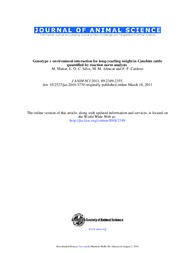Genotype × environment interaction for long-yearling weight in Canchim cattle quantified by reaction norm analysis.
Genotype × environment interaction for long-yearling weight in Canchim cattle quantified by reaction norm analysis.
Autoria: MATTAR, M.; SILVA, L. O. C. da; ALENCAR, M. M. de; CARDOSO, F. F.
Resumo: The objective of this study was to investigate the presence of genotype × environment interactions (G×E) for long-yearling weight in Canchim cattle (5/8 Charolais + 3/8 zebu) in Brazil using reaction norms (RN). The hierarchical RN model included the fixed effect of age of the animal (linear coefficient) and random effects of contemporary groups and additive animal genetic intercept and slope of the RN and contemporary group effects as random effects. Contemporary groups as the most elemental representation of management conditions in beef cattle were chosen to represent the environmental covariate of the RN. The deviance information criteria demonstrated that a homoskedastic residual RN model provided a better data fit compared with a heteroskedastic counterpart and with a traditional animal model, which had the worst fit. The environmental gradient for long-yearling weight based on contemporary group effects ranged from ?105 to 150 kg. The additive direct variance and heritability estimates increased with increasing environmental gradient from 74.33 ± 22.32 to 1,922.59 ± 258.99 kg2 and from 0.08 ± 0.02 to 0.68 ± 0.03, respectively. The high genetic correlation (0.90 ± 0.03) between the intercept and the slope of the RN shows that animals with the greatest breeding values best responded to environmental improvement, characterizing scale effect as the source of G×E for long-yearling weight. The phenotypic plasticity demonstrated by the slope of the RN of the animal indicates the possibility to change genotype expression along the environmental gradient through selection. The results demonstrate the importance of accounting for G×E in the genetic evaluation of this population.
Ano de publicação: 2011
Tipo de publicação: Artigo de periódico
Unidade: Embrapa Gado de Corte
Observações
1 - Por padrão são exibidas publicações dos últimos 20 anos. Para encontrar publicações mais antigas, configure o filtro ano de publicação, colocando o ano a partir do qual você deseja encontrar publicações. O filtro está na coluna da esquerda na busca acima.
2 - Para ler algumas publicações da Embrapa (apenas as que estão em formato ePub), é necessário ter, no celular ou computador, um desses softwares gratuitos. Sistemas Android: Google Play Livros; IOS: iBooks; Windows e Linux: software Calibre.
Acesse outras publicações
Acesse a Base de Dados da Pesquisa Agropecuária (BDPA) para consultar o acervo completo das bibliotecas da Embrapa.

